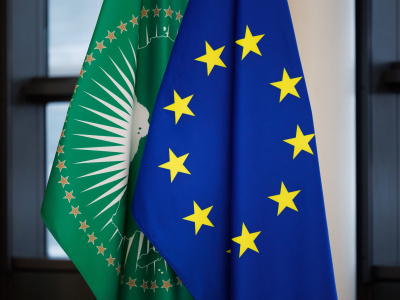
Dealing with protracted crises: No time for short-term thinking – Challenges series 2016
What's on this page
Conflict and security will continue to dominate the EU’s foreign policy agenda in 2016. The continued flow of refugees seeking asylum in Europe is a sharp reminder of how the devastating impact of conflict and humanitarian crises in the European Neighbourhood and beyond can reach within the EU’s own borders. ECDPM’s 2016 Challenges Paper states that the EU has significantly stepped up its financial resources for external action in response to humanitarian crises related to refugees. Ahead of the World Humanitarian Summit this May, Matthias Deneckere explores some of the critical issues for the EU in dealing with protracted crises.
Crises are increasingly protracted
While humanitarian needs are growing worldwide, today’s crises are increasingly protracted or recurrent. They often represent a complex mix of violent conflict, fragility and migration sometimes aggravated through natural disasters. More than 90% of the annual humanitarian appeals in 2014 were those that have carried on for 3 or more years, and more than 60% for more than 8 years. In addition, the average period of time during which people live in displacement has now reached 17 years. Humanitarian aid - although by definition temporary - is in practice becoming overwhelmingly long-term. Humanitarian organisations increasingly engage in longer-term programmes such as child vaccination or support to public health systems. These activities are not purely lifesaving but are more akin to the development sphere. This evolution is not without its critics. Are humanitarians - whose approach is focused on the short-term - well placed to tackle more structural problems underlying crises? Humanitarian organisations, peacebuilding NGOs and development organisations often work in the very same areas. So how do you avoid a fragmentation of assistance and duplication of work, while preventing gaps in support?
A long overdue summit
If we are serious about ‘leaving no one behind’ in meeting the Sustainable Development Goals, we need to have another look at how we deal with fragility and enduring crises. Clearly, the current international cooperation architecture, where humanitarian and development actors rely on different concepts, principles, channels and time frames is not fit for purpose, despite some positive trends. The World Humanitarian Summit, taking place in Istanbul on 23 and 24 May 2016, provides an opportunity to reflect on this - and it is long overdue. A UN consultation report has identified five action areas: dignity, safety, resilience, partnerships and finance for the summit. Each of these provide a window of opportunity to adapt relief practices to today’s challenges. The notions of safety and resilience recognise the need to link up humanitarian aid with diplomatic, development, peacebuilding and climate change partners. This is a promising step forward towards a paradigm shift from crisis response to a transformative approach focused on resilience, as called for by the OECD. The partnerships concept opens up opportunities to strengthen local and national leadership. It would allow a better alignment of (emergency) aid with country priorities and strengthen country systems. It also provides a window of opportunity for a greater involvement of local NGOs. They are usually the first to respond in crises, but are often not fully recognised as relevant actors in the current relief system. The High-Level Panel on Humanitarian Financing has focused on reducing needs, mobilising additional funds and improving the efficiency of humanitarian assistance. Donors should commit to predictable finance for relief, disaster risk reduction and resilience through multi-year planning, while increasing flexibility in responding to complex and protracted crises.
Does the EU have the right toolbox?
The European Commission formulated its ambitions for the Summit in a communication, which calls for a new model for humanitarian-development cooperation. But action will need to follow soon after the Summit. The Mid-Term Review of the EU’s external action instruments for the period 2014-2020, scheduled for later this year, will assess the functioning of the EU’s financing instruments. It will be an opportunity to address the recommendations of the Summit. While the EU’s institutional configuration runs the risk of working in silos - notably the divide between DG ECHO in dealing with humanitarian affairs, DG DEVCO for development and the EEAS dealing with foreign affairs - steps have been taken to overcome this. At the policy level, concepts like LRRD, Resilience and the Comprehensive Approach all aim for more complementarity and coherence in dealing with crises. Moreover, the EU has introduced more flexibility in its external action instruments, such as the B-envelopes of the European Development Fund. Also, the Instrument contributing to Stability and Peace (IcSP) provides flexible funding in cases of conflict or crisis, comprising both a preventive and responsive component. But the IcSP is mostly short-term and determined by political priorities, raising questions about its links to development interventions. EU Trust Funds offer an innovative tool to deliver flexible and comprehensive support in response to emergencies and fragility, but as argued in a recent ECDPM Briefing Note, several concerns remain including the risk of reduced ownership among partners and questions about the Trust Fund’s contribution to longer-term peacebuilding and development goals in affected countries. The UN Secretary-General recently stated that choosing between humanitarian relief and development is not a zero-sum game. The World Humanitarian Summit provides an opportunity to break down existing silos and agree on new solutions to real problems in protracted crises. As a major donor, the EU has a lot to offer, but will need to improve its practices to meet the challenges ahead.
The views expressed here are those of the author and not necessarily those of ECDPM. The author wishes to thank Volker Hauck for his contribution to and review of this article.



